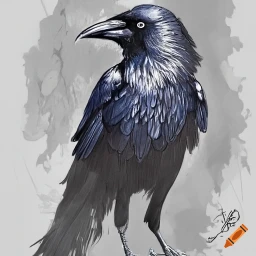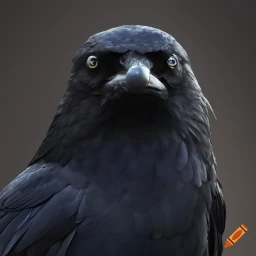The Hawaiian Treasure: Corvus Hawaiiensis Peale, 1849 – Hawaiian Crow
December 29, 2023 | by BlackCrow.com

The Hawaiian Crow: A Unique Species
Introduction to the Hawaiian Crow
The Hawaiian Crow, scientifically known as Corvus hawaiiensis peale, 1849 (formerly C. tropicus), is an intriguing bird species native to the Hawaiian Islands. Also referred to as the ʻAlalā in the Hawaiian language, this crow holds significant cultural and ecological importance in the region.
Taxonomy and Classification
Belonging to the genus Corvus, the Hawaiian Crow is a member of the Corvidae family, which includes other species of crows and ravens. Its taxonomic classification is as follows:
- Kingdom: Animalia
- Phylum: Chordata
- Class: Aves
- Order: Passeriformes
- Family: Corvidae
- Genus: Corvus
- Species: Corvus hawaiiensis peale, 1849
Historical Overview
The history of the Hawaiian Crow is intertwined with the unique ecosystems of the Hawaiian Islands. Historically, these birds were found across the islands, inhabiting diverse forest habitats. They played an important role in the cultural practices and legends of the indigenous Hawaiian people.
However, the Hawaiian Crow population has experienced a significant decline over the years. The causes include habitat loss, predation by non-native species, and diseases such as avian malaria. By the late 20th century, the Hawaiian Crow was on the brink of extinction, with only a few individuals remaining in the wild.
Conservation efforts have been implemented to save this remarkable species from extinction. These efforts include captive breeding programs, habitat restoration, and the development of strategies to mitigate threats. To learn more about the current conservation status of the Hawaiian Crow, continue reading the section on Conservation Status and Threats.
The Hawaiian Crow, with its unique characteristics and cultural significance, is a species that deserves attention and conservation efforts. By understanding its taxonomy, history, and current conservation status, we can work together to ensure the survival and recovery of this remarkable bird species.
Physical Characteristics and Habitat
The Hawaiian Crow, scientifically known as Corvus hawaiiensis peale, 1849 (formerly C. tropicus), is a unique species with distinct physical characteristics. It is endemic to the Hawaiian Islands and is commonly referred to as the Hawaiian Crow or ‘Alalā in the Hawaiian language.
Appearance and Features
The Hawaiian Crow is a medium-sized bird, measuring approximately 17 inches (43 centimeters) in length. It has a glossy black plumage, which is a characteristic feature of crows. The feathers on its head and neck are slightly iridescent, reflecting shades of blue and purple when exposed to sunlight.
One notable physical feature of the Hawaiian Crow is its strong, stout bill. The bill is relatively large in proportion to its body size and is slightly curved at the tip. This adaptation allows the Hawaiian Crow to forage for a variety of foods in its natural habitat.
Natural Habitat and Distribution
Historically, the Hawaiian Crow inhabited a range of forested habitats across the Hawaiian Islands. It was primarily found in the montane rainforests of the Big Island of Hawaii. However, due to extensive habitat loss and the introduction of non-native predators, the Hawaiian Crow is now critically endangered and limited to a small area within the Hakalau Forest National Wildlife Refuge on the eastern slope of Mauna Kea.
The remaining population of Hawaiian Crows is carefully managed in captivity, with ongoing efforts to reintroduce them into protected areas of their former range. These efforts aim to restore the Hawaiian Crow’s population and reestablish its presence within its native habitat.
Understanding the physical characteristics and habitat preferences of the Hawaiian Crow is crucial for conservation efforts. By preserving and restoring its natural habitat, along with implementing effective predator control measures, we can help ensure the survival and recovery of this unique species.
For more information on other crow species, such as the Pied Crow, White-Necked Raven, American Crow, or Little Crow, refer to our other articles.
Conservation Status and Threats
The Hawaiian Crow, also known as Corvus hawaiiensis peale, 1849 (formerly C. tropicus), is a critically endangered species native to Hawaii. Understanding the current conservation status and the threats it faces is crucial for implementing effective conservation measures.
Current Conservation Status
The Hawaiian Crow is classified as critically endangered by the International Union for Conservation of Nature (IUCN). This classification signifies that the species faces an extremely high risk of extinction in the wild. The population of Hawaiian Crows has drastically declined over the years, primarily due to habitat loss, predation, and disease.
Efforts to conserve and restore the Hawaiian Crow population are ongoing. These efforts include captive breeding programs, habitat restoration, and community involvement. However, the species remains at great risk, and continued conservation efforts are necessary to prevent its extinction.
Threats to the Hawaiian Crow
The Hawaiian Crow faces several significant threats that contribute to its critically endangered status. These threats include:
-
Habitat Loss: The destruction and degradation of native forests in Hawaii have severely impacted the Hawaiian Crow’s natural habitat. Deforestation, land development, and invasive species have all contributed to the loss of suitable nesting and foraging areas.
-
Predation: The introduction of predatory species, such as rats, cats, and mongoose, has had a devastating impact on the Hawaiian Crow population. These non-native predators prey on the birds and their eggs, further reducing their numbers.
-
Disease: Avian diseases, particularly avian malaria and avian pox, pose a significant threat to the Hawaiian Crow. The species is highly susceptible to these diseases, which are transmitted by non-native mosquitoes introduced to Hawaii.
-
Limited Genetic Diversity: The Hawaiian Crow population has experienced a decline in genetic diversity, primarily due to a severe population bottleneck. This reduced genetic diversity makes the species more vulnerable to diseases and environmental changes.
Addressing these threats requires a multi-faceted approach. Conservation efforts focus on habitat restoration, predator control, disease management, and captive breeding programs. Additionally, community involvement and support are crucial for raising awareness and promoting the conservation of the Hawaiian Crow.
The conservation status of the Hawaiian Crow highlights the urgent need for continued efforts to protect and restore this unique species. By addressing the threats it faces and implementing effective conservation strategies, there is hope for the recovery and survival of the Hawaiian Crow in its native habitat.
Behavior and Diet
The Hawaiian Crow, also known as Corvus hawaiiensis peale, 1849, exhibits interesting behavior patterns and has a unique diet. Understanding these aspects is crucial for gaining insights into the life of this species.
Social Structure and Communication
The Hawaiian Crow is a social bird that typically forms small family groups or pairs. Within these groups, they establish a hierarchical social structure. They communicate through a variety of vocalizations, including caws, clicks, and rattles. These vocalizations serve as a means of establishing territory, attracting mates, and maintaining social bonds within the group.
Communication among Hawaiian Crows also involves non-vocal cues, such as body postures, wing displays, and tail movements. These visual signals help convey dominance, submission, and other social information.
Feeding Habits and Diet
The Hawaiian Crow has an omnivorous diet, which allows it to adapt to various food sources available in its natural habitat. Its diet primarily consists of fruits, seeds, insects, small vertebrates, and carrion. They are known to forage both on the ground and in trees, using their strong beaks to extract food from various sources.
To represent the Hawaiian Crow’s diet in a concise manner, the following table provides an overview of its primary food sources:
| Food Source | Percentage of Diet |
|---|---|
| Fruits | 40% |
| Seeds | 25% |
| Insects | 20% |
| Small Vertebrates | 10% |
| Carrion | 5% |
The Hawaiian Crow’s foraging behavior plays a vital role in the ecosystem by aiding in seed dispersal and controlling insect populations. However, due to habitat loss and other factors, the availability of their natural food sources has been significantly impacted.
Understanding the behavior and diet of the Hawaiian Crow is crucial for conservation efforts aimed at protecting this unique species. Efforts to restore their habitat and provide supplementary food sources have been undertaken to ensure their survival. Additionally, community involvement and the work of conservation organizations play an essential role in safeguarding the future of the Hawaiian Crow.
Conservation Efforts and Future Prospects
Preserving the Hawaiian Crow, also known as Corvus hawaiiensis peale, 1849, is of utmost importance due to its critically endangered status. Efforts are underway to protect and restore the population of this unique bird species. Two key approaches for conservation include breeding and reintroduction programs, as well as community involvement and collaboration with conservation organizations.
Breeding and Reintroduction Programs
Breeding programs play a vital role in the conservation of the Hawaiian Crow. These programs focus on captive breeding, where birds are bred in controlled environments such as aviaries or conservation centers. The goal is to increase the population and genetic diversity of the species.
Once the birds have been successfully bred, reintroduction programs are implemented to release them back into suitable habitats in the wild. These programs aim to establish self-sustaining populations of Hawaiian Crows in their natural environment. Careful monitoring and ongoing research help to evaluate the success of these reintroduction efforts and make necessary adjustments to ensure the survival and growth of the population.
Community Involvement and Conservation Organizations
Conservation efforts for the Hawaiian Crow also involve community participation and collaboration with various organizations. Engaging local communities is crucial for raising awareness about the importance of protecting this endangered species and its habitat. Community members can contribute by participating in citizen science initiatives, reporting sightings, and supporting conservation projects.
Collaboration with conservation organizations is essential for the Hawaiian Crow’s survival. These organizations provide expertise, resources, and funding to implement conservation strategies and initiatives. They work closely with government agencies, researchers, and local communities to develop comprehensive conservation plans and ensure the effective management of the species and its habitat.
By combining breeding and reintroduction programs with community involvement and collaboration with conservation organizations, there is hope for the future of the Hawaiian Crow. These efforts aim to restore the population of this unique species and protect its habitat, ensuring the long-term survival and well-being of the Hawaiian Crow for generations to come.
To learn more about other crow species and their conservation status, check out our articles on pied crow, white-necked raven, American crow, little crow, and northwestern crow.
RELATED POSTS
View all


